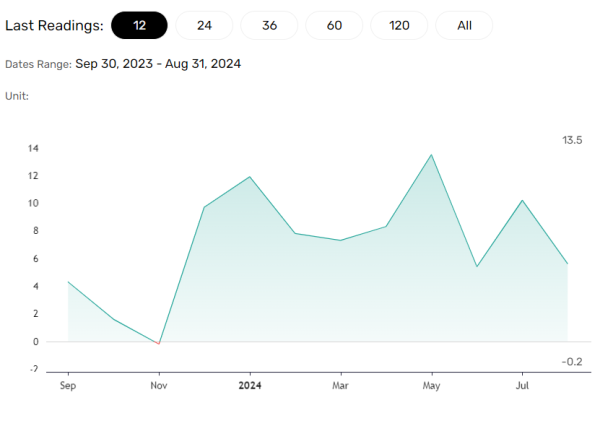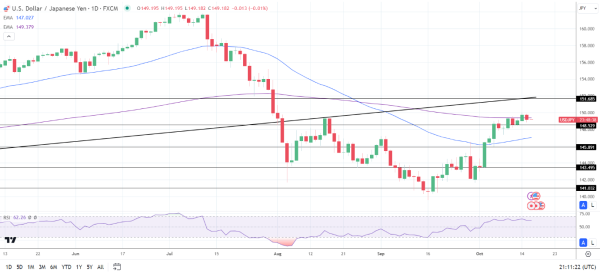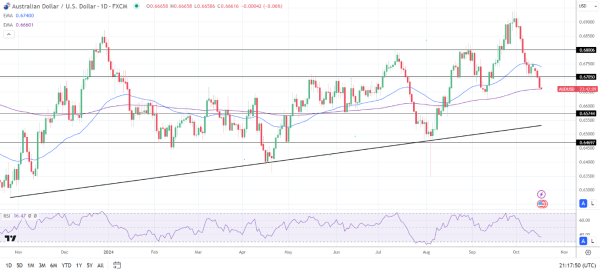Japanese Yen and Australian Dollar News: BoJ and RBA Rate Paths in Focus
Japan’s Demand Environment and Trade Data in Focus
Trade data from Japan will likely impact the USD/JPY pair on Thursday, October 17. Economists forecast exports to increase by just 0.5% year-on-year in September after rising by 5.6% in August. In contrast, economists expect imports to rise by 3.2% in September after an increase of 2.3% in August.
A modest export increase could signal a weakening demand at the end of Q3 2024. Weak demand may adversely affect the Japanese economy and its trade-to-GDP ratio of around 50%.

Conversely, a marked increase in imports could indicate a shift in domestic demand, potentially boosting future export growth and private consumption. The link between trade and domestic demand will influence USD/JPY trends.
Better-than-expected trade data could drive the USD/JPY below 149, while weak stats could push the pair through 150.
Trade Terms and the Bank of Japan Rate Path
On Wednesday, October 16, Bank of Japan Board Member Seiji Adachi noted no set timeline for a rate hike. He added that the BoJ could hike rates independently of the Fed if services sector prices drive underlying inflation higher.
Adachi echoed BoJ Governor Kazuo Ueda’s recent focus on Japan’s service sector price trends.
Japanese Yen Daily Chart
The USD/JPY lingers around the 149.5 level, failing to break above 150 for multiple sessions. US retail sales and jobless claims data could shift market sentiment toward the Fed rate path and US dollar demand.
A significant beat in retail sales and jobless claims falling below estimates could drive the USD/JPY above 150, while any miss in these indicators may support Fed rate cut bets. A more dovish Fed rate path could pull the USD/JPY below 149.

Will Australia’s Tight Labor Market Shift RBA’s Rate Strategy?
Turning to Australia, labor market data will likely impact the AUD/USD pair and the RBA rate path. Economists expect the Aussie unemployment rate to remain at 4.2% in September, with full-time employment projected to increase by 15k, after a 3.1k fall in August.
Tighter labor market conditions could boost wage growth, possibly fueling demand-driven inflation. The combination could delay RBA discussions on interest rate cuts as the Board assesses the effects on inflation.
During the latest RBA press conference, Governor Michele Bullock warned that inflation could fall within the target range, but may not reflect underlying inflation. Tighter labor market conditions and higher wages would align with the RBA’s views on inflation trends.
Australian Dollar Daily Chart
The AUD/USD is trading above $0.66500, though it remains comfortably below the September 30 high of $0.69420.
In today’s US session, a sharp retreat in jobless claims and upbeat retail sales figures could influence the Fed rate path, potentially pulling the AUD/USD toward $0.66000. Conversely, higher jobless claims could signal labor market weakness, potentially fueling expectations for aggressive Fed rate cuts. Weak US data could drive the AUD/USD toward $0.67.

Traders should remain vigilant. Today’s data from Japan and Australia could influence the respective central bank’s policy goals and trading strategies for the AUD/USD and USD/JPY pairs.